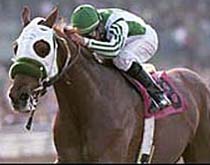|
Churchill Downs takes lead
|
 |
May 4, 2001: 12:59 p.m. ET
A changing company prepares for the Kentucky Derby and the future of racing
By Staff Writer Mark Gongloff
|
NEW YORK (CNNfn) - The bustle and glamour of this weekend's 127th running of the Kentucky Derby obscures the fact that horseracing is at a crossroads.
Some observers see flagging attendance at non-event races, disheveled tracks, and an expanding universe of entertainment alternatives, and think the "Sport of Kings" is headed for the glue factory.
| |

|
Churchill Downs
The famous spires of CDI's flagship track (Source: CDI) | |
Others see opportunities. Fittingly, the company that seems to have adapted best to recent demands is the Kentucky Derby's parent company, Churchill Downs Inc. (CDI).
Not only does CDI run the lucrative Derby -- on which about $100 million was wagered in 2000 -- it has found ways to take 25 percent of the $14.2 billion wagered on all thoroughbred racing in the United States in 2000.
"They have a clear strategy, a great brand name and top assets," Bear Stearns gaming industry analyst Marc Falcone said. "CDI could surprise some people in the next couple of years."
Slow out of the gate
CDI (CHDN: down $0.05 to $31.00, Research, Estimates) revolutionized the industry by introducing pari-mutuel betting in 1908, but did little after that to grow its business.
"It was always a small company with slow growth and not much of a strategy," said Jeffrey Thomison, an analyst with J.J.B. Hilliard, W.L. Lyons Inc.
But in the mid-1990s, President and Chief Executive Officer Thomas Meeker hired an aggressive management team to give CDI new direction.
Spurring the change was the 1978 passage of the Interstate Horseracing Act. It legalized off-track betting and spurred a proliferation of off-track betting parlors, where people bet on simulcast races in other states, and a deterioration of live racetrack attendance.
"The expansion of interstate simulcasting made it clear we were going to be much more distribution-dependent," Thomas Meeker told CNNfn.com. "We would have to deliver more products and a branded product, so you'd get the same type of racing over a longer period of time."
The development of Internet, broadband and other data-transfer technology also motivated CDI to change.
"We had an excellent opportunity to change the nature of our operation from what was a monolithic racing company to a media-based company primarily focused on distribution," Meeker said.
Accumulating racetracks
CDI's most conspicuous strategy has been its effort to, as Meeker put it, "deliver more products."
Beginning in 1994, its asset base has grown, largely through acquisitions, to six tracks in Kentucky, Indiana, California and Florida. It operates several off-track betting facilities and runs the Churchill Downs Simulcast Network, which will broadcast 680 races in 2001. It even holds a majority stake in the software company that makes the graphics for its betting parlors.
CDI's next target is New York City Off-Track Betting Corp. (NYCOTB), which takes in about $1 billion in bets every year and turns about $38 million in annual profit.
| |

|
Point Given
Kentucky Derby favorite (Source: CDI) | |
CDI has joined the New York Racing Association, which operates tracks in New York state, and the Television Games Network in a bid to buy NYCOTB from the city of New York.
With three partners absorbing the price tag, which could be as high as $400 million, acquiring NYCOTB would immediately lift CDI's bottom line.
"It's a lucrative acquisition opportunity," Bear Stearns analyst Marc Falcone said.
Most observers think CDI is favored to win NYCOTB, but its competition, Magna Entertainment Corp. (MIEC: unchanged at $5.35, Research, Estimates), also has attractive partners and a strong brand identity.
Even after New York City Mayor Rudolph Giuliani announces the winner of the NYCOTB sweepstakes -- which could happen any day -- the New York state legislature must approve the sale. Forces opposed to NYCOTB's privatization -- including labor unions -- could hinder that approval, Thomas Meeker said.
"I still hold out hope, but it will be a difficult chore to get the legislation passed," Meeker said.
International expansion
NYCOTB aside, good merger targets are scarce after a glut of acquisitions in recent years by CDI and Magna Entertainment.
For example, CDI wants to buy a track that runs races in the first quarter, at a time when CDI runs only two thoroughbred races and posts a loss. But the company has come up empty. A solution may be found overseas.

|
|
Tony Bennett
The crooner-turned-painter will provide the official artwork for the Kentucky Derby (Source: CDI) | |
"It would be helpful to get a track operating in the first quarter," Meeker said, "but not critical. As we move into the international community, there will be plenty of opportunities (for) joint ventures that will fill holes in our programming."
Analysts estimate a $100 billion global market for pari-mutuel betting, compared with the skimpy $15 billion U.S. market, but the technology for international simulcasting needs fine-tuning.
"In the next three-to-five years, the worldwide penetration of digital technology will afford us terrific opportunities," Meeker said.
CDI also hopes to reach more bettors through Television Games Network (TVGN), co-founded by Rupert Murdoch and owned by Gemstar-TV Guide (GMST: down $0.71 to $39.80, Research, Estimates).
In December, Congress said betting over the Internet and cable set-top boxes did not violate the 1961 Wire Act, allowing TVGN to operate in any state with off-track betting. Up to 35 states could allow betting over the Internet or set-top boxes, Marc Falcone said.
"This will certainly open up the sport to a lot of people who might not just go directly to a track to bet on horses," Falcone said. "That's where we see significant growth opportunities."
Building a fan base
CDI has also tried to build its fan base by strengthening its brand name, the quality of its races, and the appearance of its tracks.
"It's absolutely imperative to find and create new race fans," Thomas Meeker said. "We can't do that in the sterile environment of an off-track betting parlor or even in the home. We will create new fans when they come to the races."
The growth of off-track betting has been a double-edged sword for the industry. It generates enormous revenue -- 85 percent of CDI's $362 million in 2000 revenue – but it keeps bettors from the track.
Some tracks make slot machines and other forms of gambling available to attract customers and raise revenue. Some observers find the benefits of this practice questionable, though CIBC World Markets gaming analyst William Schmitt told CNNfn's Before Hours program he thinks it could be the future of the industry. (461K WAV) or (461K AIF)
Click here to check other horseracing stocks.
Churchill Downs and other tracks also use "family days," concerts, mascots, playgrounds and other enticements to bring youngsters to tracks and create new legions of fans, a trend disturbing to anti-gaming groups.
"Studies make it clear that teens are two-to-three times more likely to develop gambling problems than adults," said Ron Reno, spokesman for the Christian watchdog group Focus on the Family.
Thomas Meeker said CDI "recognizes its obligations" to watch out for and help problem gamblers. In any event, horseracing is generally seen as being less addictive than other forms of gambling if for no other reason than it takes so long to do it.
"Gamblers prefer to bet," said Dr. W. Scott Wood, professor of psychiatry at Drake University. "Somebody betting on horses six times a night will go broke a heck of a lot slower than somebody pulling slots six times a second."
Horseracing is also just a small fraction of the $500 billion gambling industry in the United States -- one reason, Ron Reno said, anti-gaming forces have largely left the industry alone.
"Activists are rightly focusing on the casino industry," Reno said. "It amounts to more revenue. Horseracing is largely dying across the country."
Seeking investor attention
Unfortunately for CDI, that sentiment has kept investors from its stock. Though it's posted years of steady revenue growth, CDI's stock continues to underperform. Its price-to-earnings ratio, for example, is 16.48, compared with the average S&P 500 ratio of 28.34.
"Word hasn't hit the Street about what we're doing and why we're doing it," Meeker said. "That will take some time. In the meantime, the one key thing we have to keep focused on is producing bottom-line results.
"We believe bottom-line earnings tell the story," Meeker said, "and ours is a compelling one." 
|
|
|
|
|
 |

|

